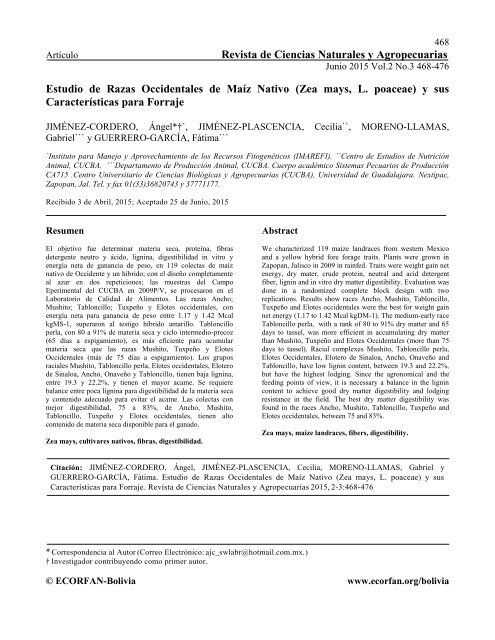Create successful ePaper yourself
Turn your PDF publications into a flip-book with our unique Google optimized e-Paper software.
Artículo<br />
468<br />
Revista de Ciencias Naturales y Agropecuarias<br />
Junio 2015 Vol.2 No.3 468-476<br />
Estudio de Razas Occidentales de Maíz Nativo (Zea mays, L. poaceae) y sus<br />
Características para Forraje<br />
JIMÉNEZ-CORDERO, Ángel*†`, JIMÉNEZ-PLASCENCIA, Cecilia``, MORENO-LLAMAS,<br />
Gabriel``` y GUERRERO-GARCÍA, Fátima```<br />
`Instituto para Manejo y Aprovechamiento de los Recursos Fitogenéticos (IMAREFI). ``Centro de Estudios de Nutrición<br />
Animal, CUCBA. ```Departamento de Producción Animal, CUCBA. Cuerpo académico Sistemas Pecuarios de Producción<br />
CA715 .Centro Universitario de Ciencias Biológicas y Agropecuarias (CUCBA), Universidad de Guadalajara. Nextipac,<br />
Zapopan, Jal. Tel. y fax 01(33)36820743 y 37771177.<br />
Recibido 3 de Abril, 2015; Aceptado 25 de Junio, 2015<br />
Resumen<br />
El objetivo fue determinar materia seca, proteína, fibras<br />
detergente neutro y ácido, lignina, digestibilidad in vitro y<br />
energía neta de ganancia de peso, en 119 colectas de maíz<br />
nativo de Occidente y un híbrido; con el diseño completamente<br />
al azar en dos repeticiones; las muestras del Campo<br />
Eperimental del CUCBA en 2009P/V, se procesaron en el<br />
Laboratorio de Calidad de Alimentos. Las razas Ancho;<br />
Mushito; Tabloncillo; Tuxpeño y Elotes occidentales, con<br />
energía neta para ganancia de peso entre 1.17 y 1.42 Mcal<br />
kgMS-1, superaron al testigo híbrido amarillo. Tabloncillo<br />
perla, con 80 a 91% de materia seca y ciclo intermedio-precoz<br />
(65 días a espigamiento), es más eficiente para acumular<br />
materia seca que las razas Mushito, Tuxpeño y Elotes<br />
Occidentales (más de 75 días a espigamiento). Los grupos<br />
raciales Mushito, Tabloncillo perla, Elotes occidentales, Elotero<br />
de Sinaloa, Ancho, Onaveño y Tabloncillo, tienen baja lignina,<br />
entre 19.3 y 22.2%, y tienen el mayor acame. Se requiere<br />
balance entre poca lignina para digestibilidad de la materia seca<br />
y contenido adecuado para evitar el acame. Las colectas con<br />
mejor digestibilidad, 75 a 83%, de Ancho, Mushito,<br />
Tabloncillo, Tuxpeño y Elotes occidentales, tienen alto<br />
contenido de materia seca disponible para el ganado.<br />
Zea mays, cultivares nativos, fibras, digestibilidad.<br />
Abstract<br />
We characterized 119 maize landraces from western Mexico<br />
and a yellow hybrid fore forage traits. Plants were grown in<br />
Zapopan, Jalisco in 2009 in rainfed. Traits were weight gain net<br />
energy, dry mater, crude protein, neutral and acid detergent<br />
fiber, lignin and in vitro dry matter digestibility. Evaluation was<br />
done in a randomized complete block design with two<br />
replications. Results show races Ancho, Mushito, Tabloncillo,<br />
Tuxpeño and Elotes occidentales were the best for weight gain<br />
net energy (1.17 to 1.42 Mcal kgDM-1). The medium-early race<br />
Tabloncillo perla, with a rank of 80 to 91% dry matter and 65<br />
days to tassel, was more efficient in accumulating dry matter<br />
than Mushito, Tuxpeño and Elotes Occidentales (more than 75<br />
days to tassel). Racial complexes Mushito, Tabloncillo perla,<br />
Elotes Occidentales, Elotero de Sinaloa, Ancho, Onaveño and<br />
Tabloncillo, have low lignin content, between 19.3 and 22.2%,<br />
but have the highest lodging. Since the agronomical and the<br />
feeding points of view, it is necessary a balance in the lignin<br />
content to achieve good dry matter digestibility and lodging<br />
resistance in the field. The best dry matter digestibility was<br />
found in the races Ancho, Mushito, Tabloncillo, Tuxpeño and<br />
Elotes occidentales, between 75 and 83%.<br />
Zea mays, maize landraces, fibers, digestibility.<br />
Citación: JIMÉNEZ-CORDERO, Ángel, JIMÉNEZ-PLASCENCIA, Cecilia, MORENO-LLAMAS, Gabriel y<br />
GUERRERO-GARCÍA, Fátima. Estudio de Razas Occidentales de Maíz Nativo (Zea mays, L. poaceae) y sus<br />
Características para Forraje. Revista de Ciencias Naturales y Agropecuarias 2015, 2-3:468-476<br />
* Correspondencia al Autor (Correo Electrónico: ajc_swlabr@hotmail.com.mx.)<br />
† Investigador contribuyendo como primer autor.<br />
© ECORFAN-Bolivia www.ecorfan.org/bolivia


